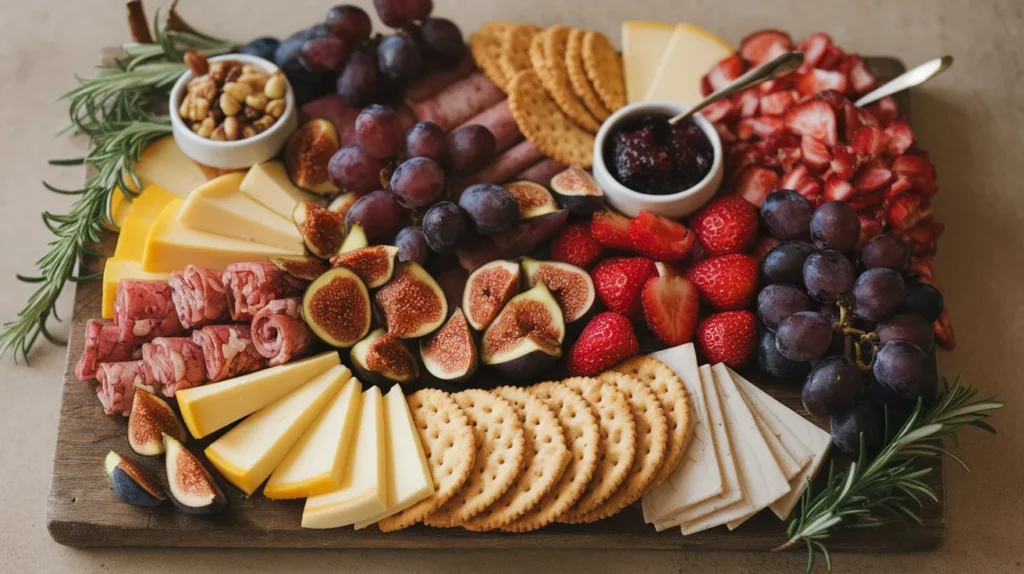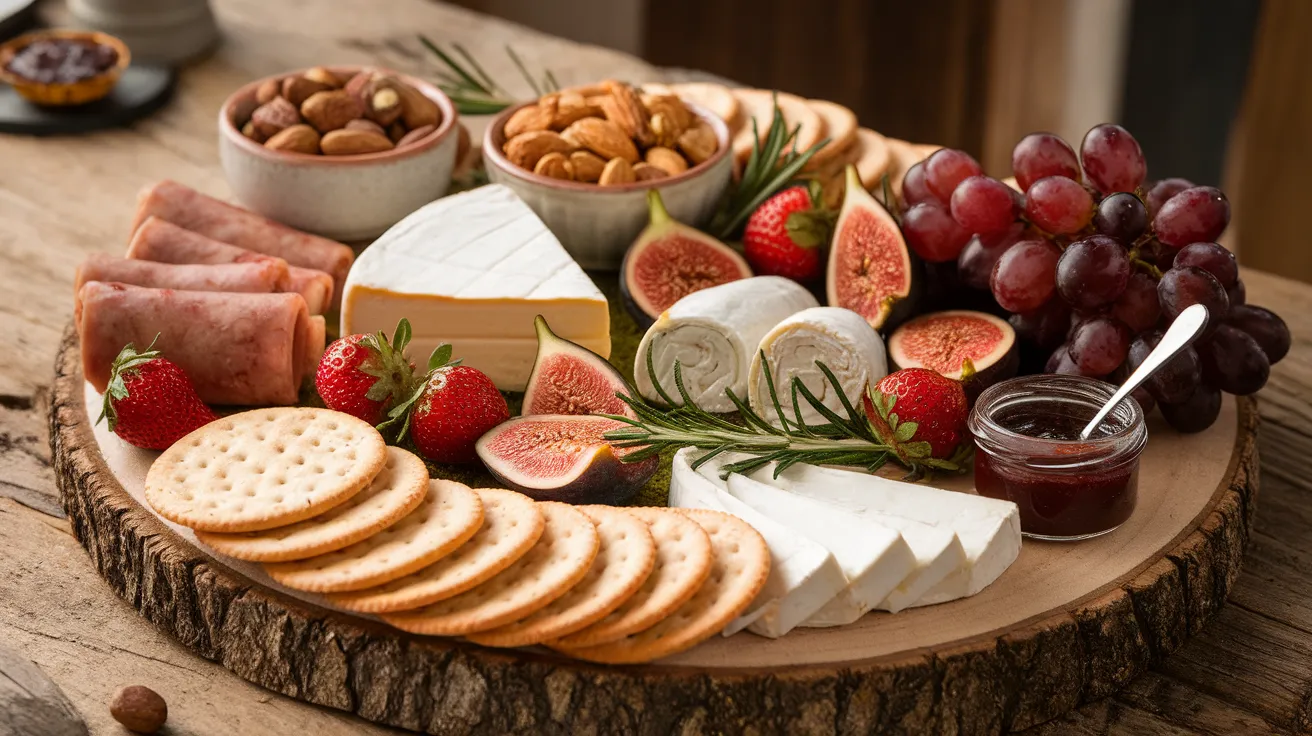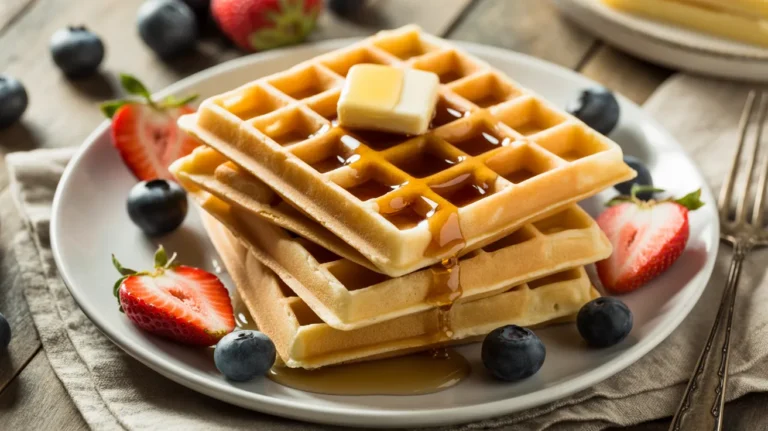This stunning vegan charcuterie board transforms plant-based ingredients into an elegant spread that rivals any traditional cheese board. Perfect for entertaining, this vegan charcuterie board combines creamy cashew cheeses, savory plant-based meats, fresh fruits, and artisanal crackers into a colorful masterpiece that serves four people beautifully. Even complete beginners can create this impressive vegan charcuterie board with our detailed step-by-step approach.
Recipe Info
SERVES: 4 | PREP: 20 MIN | COOK: 25 MIN | TOTAL: 45 MIN
Ingredients
Vegan Cheeses
| Ingredient | Amount |
|---|---|
| Cashew cream cheese | 8 oz |
| Aged vegan cheddar | 6 oz |
| Herbed almond cheese | 4 oz |
| Vegan brie-style cheese | 4 oz |
Plant-Based Meats
| Ingredient | Amount |
|---|---|
| Vegan salami slices | 3 oz |
| Plant-based prosciutto | 2 oz |
| Smoky tempeh strips | 4 oz |
Fresh & Dried Fruits
| Ingredient | Amount |
|---|---|
| Red grapes | 1 cup |
| Fresh figs | 4 medium |
| Dried apricots | 1/2 cup |
| Fresh strawberries | 8 large |
Nuts & Olives
| Ingredient | Amount |
|---|---|
| Mixed olives | 1/2 cup |
| Candied walnuts | 1/3 cup |
| Raw almonds | 1/4 cup |
| Pistachios | 1/4 cup |
Accompaniments
| Ingredient | Amount |
|---|---|
| Artisan crackers | 2 varieties |
| Fig jam | 1/4 cup |
| Whole grain mustard | 2 tbsp |
| Fresh rosemary sprigs | 4 sprigs |
Detailed Vegan Charcuterie Board Assembly Instructions
Phase 1: Preparation and Setup (15 minutes)
- Choose and prepare your serving board. Select a wooden board or large platter that measures at least 18 inches long by 12 inches wide. This size comfortably holds all ingredients without overcrowding. Wipe the surface clean with a damp cloth, then dry completely. If using wood, ensure it’s food-safe and hasn’t been treated with harmful chemicals.
- Remove all vegan cheeses from refrigeration exactly 30 minutes before assembly. This is crucial for your vegan charcuterie board success. Cold cheese is difficult to spread and has muted flavors. Place each cheese variety on a separate small plate and cover loosely with clean kitchen towels. The cashew cream cheese should feel soft when gently pressed, while firmer cheeses like aged cheddar should yield slightly to pressure.
- Gather all your tools in one location. You’ll need: 4 small cheese knives (or clean butter knives), 2 small spoons for jams, 4-6 small bowls for nuts and olives, clean kitchen scissors for trimming, and a clean damp towel for wiping your hands. Having everything ready prevents rushing and ensures better presentation.
- Wash and completely dry all fresh produce. Use cool running water and gently scrub grapes and strawberries. Pat everything dry with paper towels or clean kitchen towels. Any moisture left on fruits will make your crackers soggy and create an unappealing appearance on your vegan charcuterie board.
Phase 2: Strategic Cheese Placement (8 minutes)
- Start with your largest vegan cheese wedge as the anchor. Take your vegan brie-style cheese and place it in the upper right quadrant of your board, about 3 inches from the edge. This creates a visual starting point. The creamy, light-colored brie provides excellent contrast against darker ingredients you’ll add later.
- Position the aged vegan cheddar diagonally opposite. Place this firmer cheese in the lower left area, creating visual balance. Leave approximately 4-5 inches between cheeses to allow room for crackers and accompaniments. If your cheddar is in a block, angle it slightly rather than placing it perfectly square – this looks more natural and inviting.
- Add the herbed almond cheese in the upper left corner. This creates a triangular pattern with your first two cheeses. The herbs in this cheese will add lovely green color flecks to your vegan charcuterie board. Position it so the herbs are visible from the top.
- Place the cashew cream cheese in the remaining space (lower right). Since this is the softest cheese, position it where guests can easily access it without reaching over other ingredients. If it comes in a container, transfer it to a small bowl or leave it in an attractive container with a spreading knife.
Phase 3: Plant-Based Meat Arrangement (7 minutes)
- Begin with vegan salami placement around the brie cheese. Take each salami slice and fold it in half, then fold again to create a quarter-circle shape. This technique, called “fanning,” adds height and visual interest. Arrange 5-6 pieces in a gentle curve around the brie, leaving about 1 inch of space between the cheese and meat.
- Create prosciutto rosettes near the cheddar. Take each thin slice of plant-based prosciutto and gently roll it from one end to create a loose spiral. Don’t roll too tightly – you want it to look natural and organic. Place 4-5 rosettes near the aged cheddar, clustering them together for visual impact.
- Prepare and position tempeh strips strategically. Using clean kitchen scissors or a sharp knife, cut tempeh into 2-inch long strips, about 1/2 inch wide. Stack 3-4 pieces together and place these small stacks in the spaces between your cheese sections. The smoky flavor and darker color provide excellent contrast on your vegan charcuterie board.
Phase 4: Fresh Fruit Integration (10 minutes)
- Prepare figs with precision for maximum visual impact. Using a sharp paring knife, cut each fig lengthwise into quarters, starting from the top and cutting down toward the stem end. This reveals the beautiful interior pattern. Fan out each quartered fig slightly and place them near the herbed almond cheese. The purple exterior and pink interior create stunning color contrast.
- Create natural grape clusters throughout the board. Instead of placing one large grape bunch, break grapes into smaller clusters of 4-6 grapes each. Use clean kitchen scissors to cut stems, leaving about 1/2 inch of stem for easy handling. Scatter these mini-clusters in 3-4 locations around your vegan charcuterie board, filling empty spaces naturally.
- Prepare strawberries for optimal presentation. Remove green tops with a paring knife, cutting at a slight angle to create an attractive surface. If strawberries are larger than 1 inch in diameter, cut them in half lengthwise to show the interior pattern. Arrange cut-side up near the cashew cream cheese, as the sweet berries pair beautifully with creamy textures.
- Strategically place dried apricots for color balance. These provide essential orange color to complement the reds and greens already on your board. Group 3-4 apricots together in small clusters rather than scattering them randomly. Place them near the aged cheddar, as their sweetness balances the sharp cheese flavor perfectly.
Phase 5: Nuts, Olives, and Final Elements (5 minutes)
- Fill small bowls with nuts and olives before placing on board. Use 4 small bowls (2-3 inch diameter works perfectly). Put mixed olives in one bowl, candied walnuts in another, almonds in a third, and pistachios in the fourth. Never place loose olives directly on the board – the brine will affect other ingredients and create a mess.
- Nestle filled bowls into natural gaps on your vegan charcuterie board. Look for spaces between cheese and meat sections where bowls fit comfortably without crowding. The bowls should sit securely and not wobble. If a bowl seems unstable, create a small foundation using folded paper towels underneath (hidden from view).
- Add crackers in strategic locations for easy access. Don’t pile all crackers in one area – instead, create 3-4 small stacks of different cracker varieties around the board. Fan out some crackers near each cheese variety, making it obvious which combinations work well together. Leave space between crackers for easy grabbing.
Phase 6: Condiments and Final Garnishes (3 minutes)
- Position condiments with appropriate serving utensils. Place fig jam in a small bowl with a tiny spoon near the vegan brie and cashew cream cheese – these pair beautifully. Position whole grain mustard (also with its own small spoon) near the plant-based meats and firmer cheeses. Never let condiment spoons touch multiple items as this transfers flavors.
- Add fresh rosemary sprigs as aromatic finishing touches. Gently rinse rosemary and shake dry. Tuck 2-3 small sprigs into gaps around the board – not clustered together, but distributed for visual balance. The herb’s piney fragrance enhances the overall sensory experience of your vegan charcuterie board. Avoid placing rosemary directly on soft cheeses where it might sink in.
Phase 7: Final Quality Check and Presentation (2 minutes)
- Step back and assess your vegan charcuterie board for balance. Check that you have good color distribution – reds, greens, whites, and browns should appear throughout rather than clustered in sections. Adjust any elements that look crowded or sparse. This is your chance to perfect the presentation before guests arrive.
- Add final serving tools and provide guest guidance. Place appropriate knives near each cheese variety – soft cheeses need spreading knives while firm cheeses need sharper cutting tools. Consider creating one “example bite” on a small plate showing ideal proportions – perhaps a cracker topped with cashew cheese, a fold of plant-based prosciutto, and a grape half. This guides guests toward successful combinations.
Chef’s Notes
• Temperature control is crucial for your vegan charcuterie board success. Serve cheeses at room temperature but keep the assembled board in a cool area (65-70°F) to prevent spoilage during extended serving periods.
• Quality vegan cheeses make the difference between good and exceptional. Invest in artisanal plant-based options rather than processed alternatives for authentic flavors and textures that will impress even non-vegan guests.
• Build your first vegan charcuterie board on parchment paper if you’re nervous about arrangement. You can slide ingredients directly onto your final serving board once satisfied with the layout.
• Prepare individual components up to 2 hours ahead but assemble just before serving to maintain optimal freshness and prevent colors from bleeding or textures from deteriorating.
Nutrition Information (Per Serving)
- Calories: 485
- Protein: 18g
- Carbohydrates: 32g
- Fat: 28g
- Fiber: 8g
- Sodium: 680mg
Vegan Charcuterie Board Variations
Mediterranean Vegan Board
Replace standard ingredients with sun-dried tomatoes, vegan feta, roasted red peppers, and hummus varieties. Add pita chips and fresh herbs for an authentic Mediterranean experience that transforms your basic vegan charcuterie board into a coastal feast.
Sweet & Savory Combination
Include elements from our vegan cheesecake recipe by adding mini dessert portions alongside savory items for a unique twist that surprises guests.
Seasonal Autumn Vegan Charcuterie Board
Incorporate roasted butternut squash, candied pecans, dried cranberries, and warm spices. Perfect for fall entertaining with rich, cozy flavors that celebrate seasonal abundance.
Birthday Celebration Board
Transform your spread into party fare by including colorful elements inspired by our vegan cupcakes – think rainbow fruits and festive garnishes that make any vegan charcuterie board celebration-worthy.
Storage & Reheating
Immediate Storage: Cover assembled board with plastic wrap and refrigerate for up to 4 hours. Remove 30 minutes before serving to restore proper temperatures.
Component Storage: Store individual elements separately in airtight containers. Vegan cheeses last 5-7 days, while fresh fruits should be consumed within 2-3 days.
Make-Ahead Strategy: Prepare nuts, dried fruits, and condiments up to 1 week ahead. Purchase vegan cheeses 2 days early to ensure optimal ripeness.
Leftover Management: Transform remaining ingredients into sandwiches, salads, or pasta dishes within 48 hours of original assembly.

Troubleshooting Your Vegan Charcuterie Board
Problem: Vegan cheeses are too firm
Solution: Remove from refrigeration 45 minutes early instead of 30. Some plant-based cheeses require longer softening time than dairy alternatives, especially during colder months.
Problem: Board looks sparse or unbalanced
Solution: Add more height variation using small bowls, ramekins, or folded napkins under ingredients to create natural elevation changes throughout your vegan charcuterie board.
Problem: Colors appear muddy or monotone
Solution: Ensure you have elements from each color family: reds (strawberries), greens (grapes), whites (cheeses), and browns (nuts, crackers). Bright colors should be distributed evenly.
Problem: Guests don’t know how to eat combinations
Solution: Pre-assemble 2-3 sample bites on small plates as examples, showing ideal flavor pairings and proportions that work best on your vegan charcuterie board.
Problem: Board becomes messy during serving
Solution: Provide individual small plates, cheese knives for each variety, and cocktail napkins. Position serving utensils strategically throughout the arrangement to maintain organization.
Equipment Essentials
• Large wooden board or slate (18-20 inches minimum) • Small cheese knives (3-4 different styles) • Small spoons for jams and mustards • Small bowls for olives and nuts (4-6 pieces) • Offset spatula for spreading soft cheeses • Sharp paring knife for fruit preparation • Clean kitchen towels for wiping surfaces
Shopping List
Refrigerated Section
- Cashew cream cheese (8 oz)
- Aged vegan cheddar (6 oz)
- Herbed almond cheese (4 oz)
- Vegan brie-style cheese (4 oz)
Deli/Prepared Foods
- Vegan salami slices (3 oz)
- Plant-based prosciutto (2 oz)
- Mixed olives (1/2 cup)
Produce Section
- Red grapes (1 cup)
- Fresh figs (4 medium)
- Fresh strawberries (8 large)
- Fresh rosemary (1 package)
Pantry/Dry Goods
- Smoky tempeh (4 oz)
- Dried apricots (1/2 cup)
- Candied walnuts (1/3 cup)
- Raw almonds (1/4 cup)
- Pistachios (1/4 cup)
- Artisan crackers (2 varieties)
- Fig jam (small jar)
- Whole grain mustard (small jar)
Success Secrets for Your Vegan Charcuterie Board
- Start with your largest elements first and work toward smaller details. This prevents overcrowding and ensures balanced distribution across your entire vegan charcuterie board.
- Create odd-numbered groupings of ingredients (clusters of 3 or 5) for more visually appealing, natural-looking arrangements that follow design principles.
- Use the “triangle rule” – arrange key elements in triangular patterns across the board to create visual flow and prevent linear, predictable layouts.
- Taste-test your vegan cheeses beforehand to understand their flavor profiles and suggest optimal pairings to guests who may be unfamiliar with plant-based options.
- Keep backup ingredients handy – extra crackers, fruits, and nuts ensure your vegan charcuterie board stays abundant throughout the entire gathering, maintaining its impressive appearance from start to finish.




